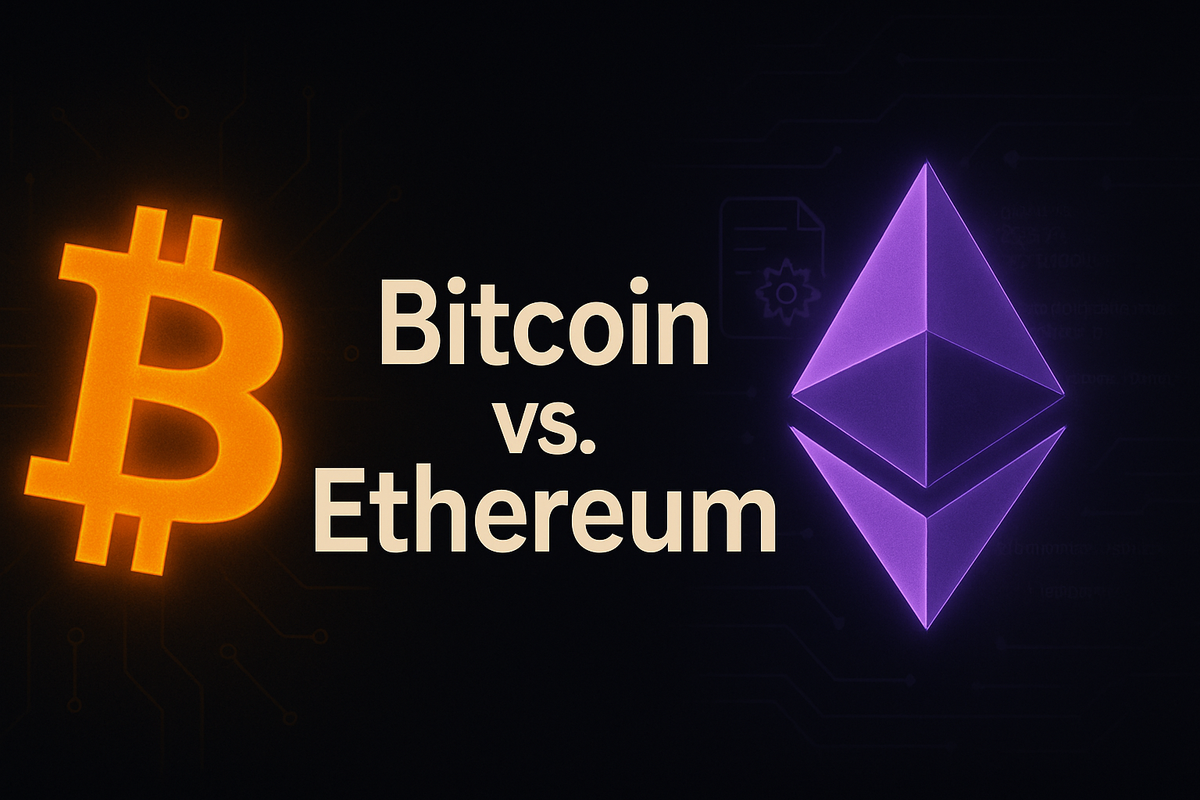Bitcoin vs. Ethereum: What’s the Real Difference?
Bitcoin and Ethereum are the top two cryptocurrencies — but they serve very different roles. This guide breaks down their differences in design, use cases, and investment potential.

Bitcoin and Ethereum are the two most prominent cryptocurrencies in the world, but they serve fundamentally different purposes. While both operate on blockchain technology and are decentralized by design, their core objectives, use cases, and technological underpinnings diverge significantly.
Bitcoin, launched in 2009, was created as a peer-to-peer digital currency and a store of value — often referred to as "digital gold." Ethereum, which followed in 2015, was designed to be a decentralized platform for smart contracts and applications.
For newcomers and experienced investors alike, understanding the differences between these two giants is essential. Their contrasting roles within the crypto ecosystem influence everything from investment strategy to technical development.
In this article, we’ll break down the key distinctions — from how they work under the hood to how they’re used in the real world — so you can better grasp where each stands in the broader blockchain landscape.
Origins and Purpose
Bitcoin and Ethereum were born from different visions of what blockchain technology could achieve.
Bitcoin was introduced in 2009 by an anonymous figure known as Satoshi Nakamoto. Its core purpose was to serve as a decentralized digital currency — a response to the failures of traditional financial institutions highlighted during the 2008 global financial crisis. Bitcoin aimed to give individuals full control over their money by removing intermediaries like banks. Its fixed supply of 21 million coins reinforced its role as a store of value, positioning it as "digital gold" in the eyes of many investors.
Ethereum, launched in 2015 by a team led by Vitalik Buterin, expanded the concept of blockchain beyond simple transactions. While Bitcoin was designed for secure value transfer, Ethereum was built to be a programmable platform. It introduced smart contracts — self-executing agreements written in code — enabling developers to build decentralized applications (dApps) on its blockchain. The Ethereum network became a sandbox for experimentation in decentralized finance (DeFi), NFTs, DAOs, and more.
In essence, Bitcoin is a monetary system, while Ethereum is a decentralized computing platform. One is designed to preserve value, the other to build value through utility. This foundational difference sets the stage for the technical and functional contrasts that follow.
Consensus Mechanisms
At the heart of any blockchain is a consensus mechanism — the process by which nodes agree on the validity of transactions. Bitcoin and Ethereum use different systems to achieve this, reflecting their differing priorities.
Bitcoin relies on Proof of Work (PoW), the original consensus mechanism. In PoW, miners compete to solve complex mathematical puzzles, and the first to solve it earns the right to add a new block to the blockchain. This system is robust and battle-tested, but it’s also resource-intensive, requiring significant energy consumption. PoW was chosen for its simplicity, security, and decentralization — essential for a monetary system with no central authority.
Ethereum also used PoW initially but transitioned to Proof of Stake (PoS) with the Ethereum 2.0 upgrade (finalized in 2022). In PoS, validators are chosen to create new blocks and confirm transactions based on how much ETH they’ve staked as collateral. This system significantly reduces energy usage and increases scalability while maintaining security. Validators are rewarded with ETH for their participation and penalized for malicious activity.
The shift to PoS marks one of Ethereum’s most ambitious upgrades and underscores its adaptability. While Bitcoin remains committed to PoW for its security guarantees, Ethereum's move to PoS highlights its focus on innovation, scalability, and sustainability.
Smart Contracts and dApps
One of the most defining differences between Bitcoin and Ethereum lies in their programmability — specifically, their support for smart contracts and decentralized applications (dApps).
Ethereum was designed from the ground up as a smart contract platform. Smart contracts are self-executing agreements written in code, which automatically carry out terms once predefined conditions are met. These contracts live on the Ethereum Virtual Machine (EVM), a decentralized computing environment that allows developers to build and deploy a wide range of applications directly on the blockchain.
This programmability has unlocked an entire ecosystem of innovation: decentralized finance (DeFi) platforms, NFT marketplaces, DAO governance structures, and more. Ethereum’s flexibility has made it the go-to blockchain for developers seeking to build Web3 applications, giving it a dynamic, evolving use case far beyond currency.
Bitcoin, by contrast, is far more limited in its scripting capabilities. While it does allow basic conditional operations through its own scripting language, it's intentionally restricted to minimize security vulnerabilities. Some layer-2 projects like Stacks and Rootstock are attempting to bring smart contract functionality to Bitcoin, but these are not native features and remain peripheral to Bitcoin’s core design.
In essence, Ethereum is programmable money, while Bitcoin is more akin to digital gold. Ethereum’s smart contract functionality positions it as a platform for building, whereas Bitcoin remains focused on secure, censorship-resistant value transfer.
Supply and Monetary Policy
Bitcoin and Ethereum take fundamentally different approaches to supply and issuance, reflecting their respective philosophies.
Bitcoin has a hard-coded supply cap of 21 million coins. This finite limit is one of its most defining features and is central to its appeal as a store of value. New bitcoins are released through mining rewards, which are halved approximately every four years in an event known as the halving. This controlled issuance creates a predictable deflationary model, drawing comparisons to scarce commodities like gold.
Ethereum, in contrast, does not have a fixed supply cap, though its monetary policy has evolved over time. Initially, Ethereum had a steady inflationary issuance model, but this changed significantly after major upgrades. The introduction of EIP-1559 (in 2021) implemented a fee-burning mechanism that destroys a portion of transaction fees, effectively reducing the overall supply. Combined with Ethereum’s shift to Proof of Stake, the network has sometimes experienced periods of net deflation, where more ETH is burned than issued.
While Bitcoin emphasizes scarcity, Ethereum now balances issuance with usage, aligning supply with network activity. These divergent approaches reflect each network’s core priorities: stability versus flexibility.
Transaction Speed and Fees
Transaction speed and cost are crucial for user experience — and both Bitcoin and Ethereum face trade-offs between speed, scalability, and decentralization.
Bitcoin was designed for security and decentralization, not speed. The network processes about 3–7 transactions per second (TPS), with a new block added approximately every 10 minutes. This means transactions can take several minutes to confirm, especially during times of high network demand. Fees are determined by block space competition — they rise when more people are trying to transact at once.
Ethereum offers faster settlement, with blocks added every 12–14 seconds, and a higher TPS — typically 15–30, though it varies. However, this advantage comes at the cost of congestion and volatile gas fees, which can spike dramatically during popular NFT mints or DeFi activity. Ethereum’s shift to Proof of Stake and its ongoing rollup-centric scaling roadmap (like zk-rollups and Optimism) are aimed at reducing fees and improving throughput.
In summary, Ethereum is faster but often more expensive in peak periods, while Bitcoin offers slower but more predictable processing. Both networks are working on scaling solutions, but their design choices reflect different priorities.
Use Cases and Ecosystem
Bitcoin and Ethereum support vastly different ecosystems, reflecting their core functionalities and communities.
Bitcoin has a relatively narrow but powerful use case: acting as a decentralized store of value and medium of exchange. It is used primarily for wealth preservation, remittances, and in some cases, payments where censorship resistance is valued. Bitcoin’s ecosystem includes custodial and non-custodial wallets, exchanges, and increasingly, Layer 2 solutions like the Lightning Network, which enable faster and cheaper transactions. However, the development pace is cautious, with a strong preference for stability over rapid innovation.
Ethereum, by contrast, powers a sprawling ecosystem of decentralized applications. It’s the backbone of DeFi, where users can lend, borrow, trade, and earn yields without intermediaries. It also hosts NFT platforms, DAO governance systems, play-to-earn games, and a growing range of Web3 applications. Developers flock to Ethereum for its flexibility and active community, and numerous protocols — like Uniswap, Aave, and OpenSea — were born on the Ethereum network.
Additionally, Ethereum is a hub for innovation beyond finance. Projects focused on identity, supply chain, and social networking are exploring Ethereum-based solutions. This vibrant, fast-moving ecosystem makes Ethereum a platform not just for currency, but for permissionless innovation.
In essence, Bitcoin is laser-focused on being sound money. Ethereum, meanwhile, aims to be the infrastructure for a decentralized internet.
Security and Network Stability
Security is foundational to both Bitcoin and Ethereum, but each network approaches it in unique ways aligned with their goals and architecture.
Bitcoin is considered the most secure blockchain in existence. Its security stems from its robust Proof of Work mechanism, massive hash power, and conservative approach to protocol changes. The network has operated with near-perfect uptime since its launch in 2009, earning a reputation for resilience and reliability. Its smaller, more intentional codebase and slower development cycle further enhance stability — ideal for a digital asset aiming to be a global reserve currency.
Ethereum, while also highly secure, balances innovation with complexity. With the transition to Proof of Stake, its security model shifted from computational power to economic stake. Validators risk losing their staked ETH if they act maliciously, providing a strong financial incentive to maintain honest behavior. Ethereum’s frequent upgrades and expansive ecosystem introduce a larger attack surface, but its developer community and bug bounty programs help mitigate these risks.
Both networks are decentralized and resistant to censorship. However, Bitcoin prioritizes maximum security with minimal changes, while Ethereum embraces iterative improvement — offering powerful features at the cost of slightly greater complexity.
Environmental Impact
Energy consumption has become a defining point of comparison between Bitcoin and Ethereum, particularly in the context of environmental sustainability.
Bitcoin continues to use the Proof of Work (PoW) consensus mechanism, which requires miners to expend large amounts of computational energy to secure the network. Critics argue that this contributes to carbon emissions, especially when mining operations rely on fossil fuels. Supporters counter that a growing percentage of Bitcoin mining uses renewable energy, and that PoW is essential for decentralized security.
Ethereum, in contrast, dramatically reduced its environmental footprint by transitioning to Proof of Stake (PoS) in 2022. The Ethereum Foundation estimates this shift cut the network’s energy consumption by over 99%. Validators in PoS no longer need energy-intensive hardware; instead, they secure the network by locking up ETH in smart contracts.
This change positions Ethereum as a greener blockchain platform — a key advantage in an increasingly ESG-conscious world. Bitcoin remains the most energy-intensive major blockchain, while Ethereum has proactively addressed its sustainability concerns through a fundamental protocol shift.
Investment Considerations
From an investor’s perspective, Bitcoin and Ethereum offer different value propositions, risk profiles, and potential roles in a portfolio.
Bitcoin is often seen as a store of value — the digital equivalent of gold. Its fixed supply and long track record give it an edge in terms of perceived stability and predictability. Many investors allocate Bitcoin as a hedge against inflation, currency debasement, or macroeconomic instability. Its simplicity and widespread adoption make it a favored entry point for institutional investors and long-term holders.
Ethereum, on the other hand, is a growth asset with significant upside — and risk. As the foundational layer of decentralized finance, NFTs, and Web3, Ethereum offers exposure to a broad innovation ecosystem. However, its value is tied not just to scarcity, but to network usage and developer adoption, which makes it more volatile and susceptible to rapid shifts in sentiment or competition from other smart contract platforms.
Investors often compare the two as a "store of value vs. tech play" decision. While Bitcoin is the safer, more conservative bet, Ethereum has a more dynamic risk-reward profile. Many diversified crypto portfolios include both — using Bitcoin as a stable core and Ethereum as an exposure to broader innovation.
Conclusion: Bitcoin vs. Ethereum: Which Is Better?
Bitcoin and Ethereum are the twin pillars of the cryptocurrency world, but they serve very different purposes. Bitcoin prioritizes security, simplicity, and scarcity — making it ideal as a store of value. Ethereum, by contrast, is a flexible platform powering decentralized applications and smart contracts, driving innovation across Web3.
Understanding their differences is key to navigating the crypto ecosystem — whether you're an investor, developer, or simply curious. Rather than asking which is better, the more useful question is: which is better for your goals? In many cases, the answer may be both — for very different reasons.
Bitcoin vs. Ethereum: FAQ
Bitcoin is often preferred by beginners due to its simpler purpose as digital money and its lower technical complexity compared to Ethereum.
While Ethereum has more utility, Bitcoin’s strong brand and store-of-value status make it difficult to surpass in total market capitalization—for now.
Yes. Ethereum’s switch to Proof of Stake reduced its energy usage by over 99%, making it far more eco-friendly than Bitcoin’s Proof of Work.
Ethereum natively supports smart contracts. Bitcoin has limited functionality in this area and relies on external protocols for expanded programmability.
Ethereum usually has higher transaction fees, especially during network congestion, due to its demand for smart contracts and decentralized apps.
Bitcoin is often seen as a stable store of value, while Ethereum offers higher growth potential due to its expanding application ecosystem.





